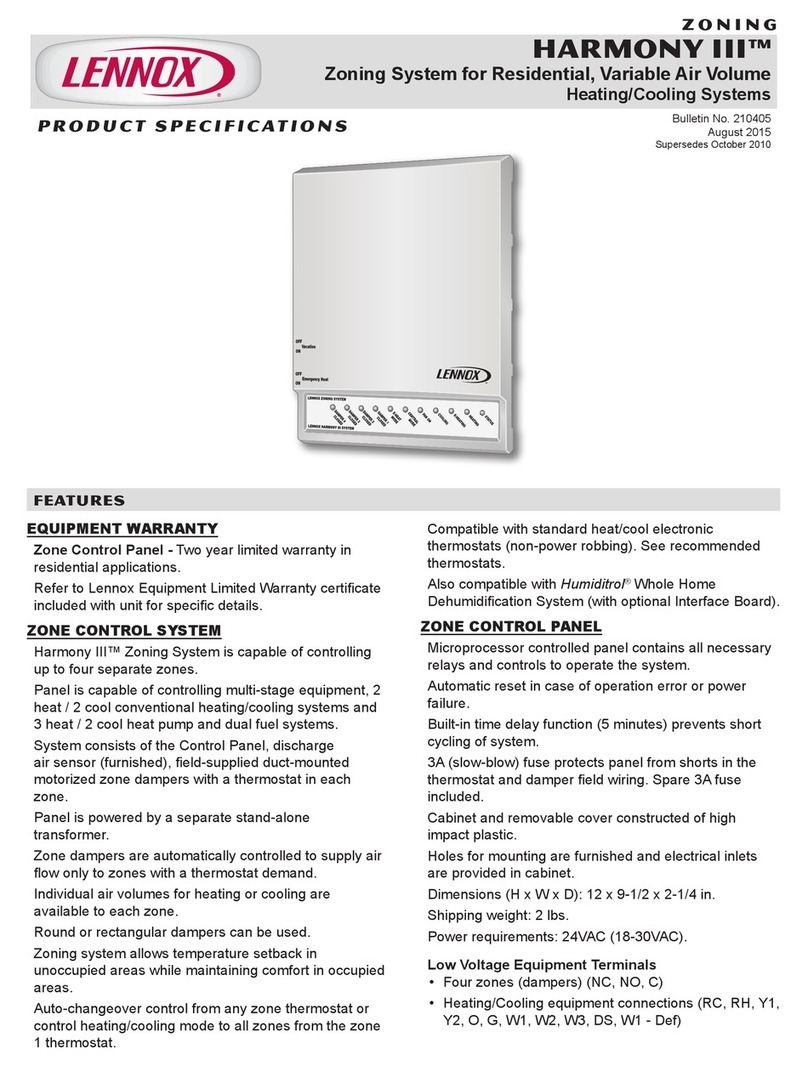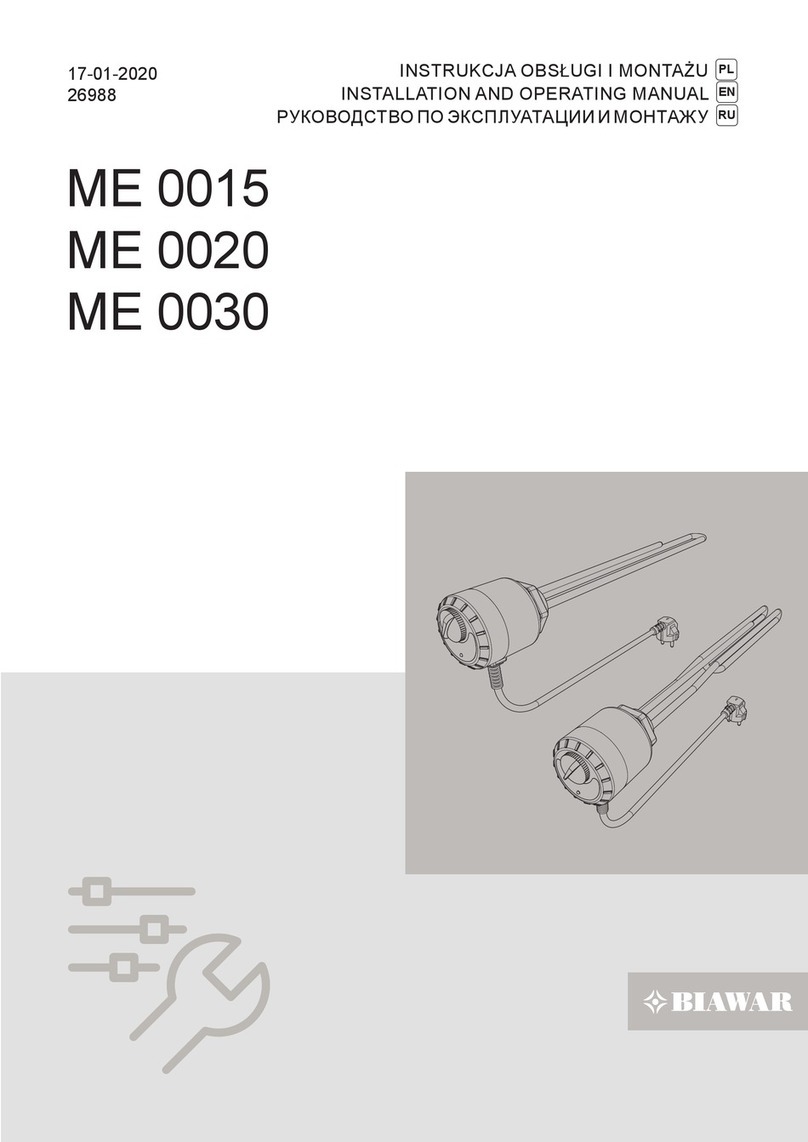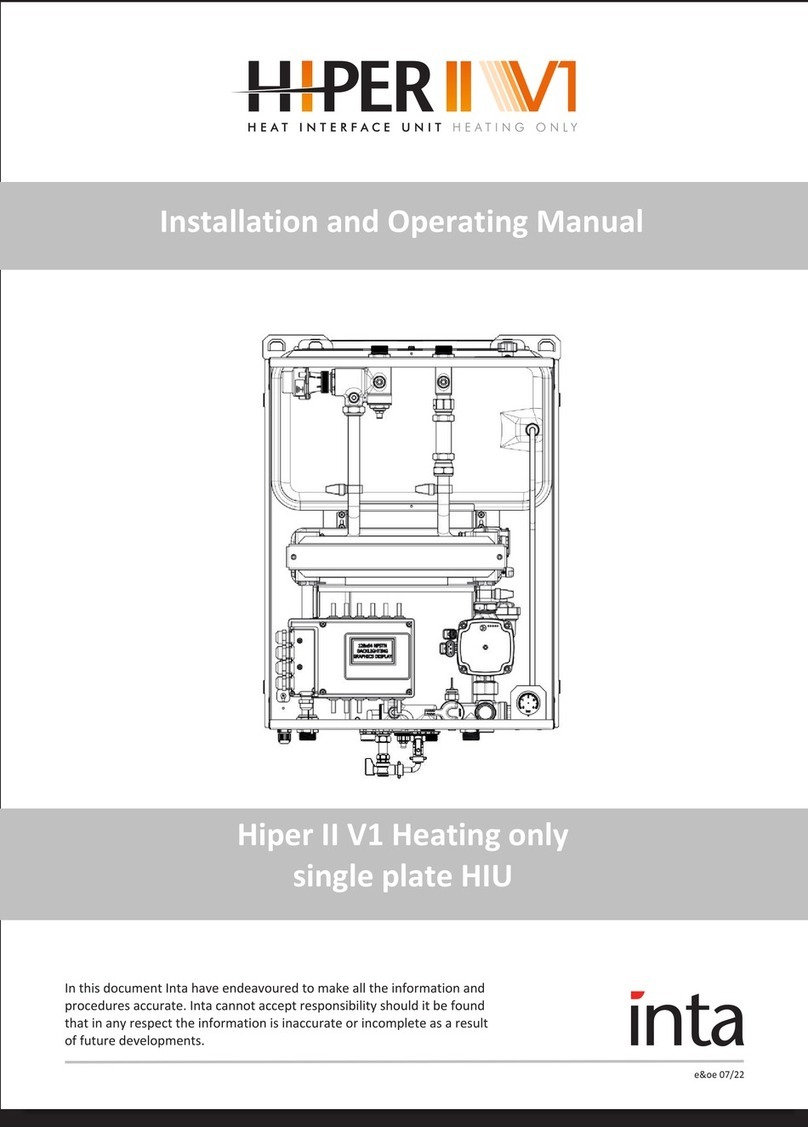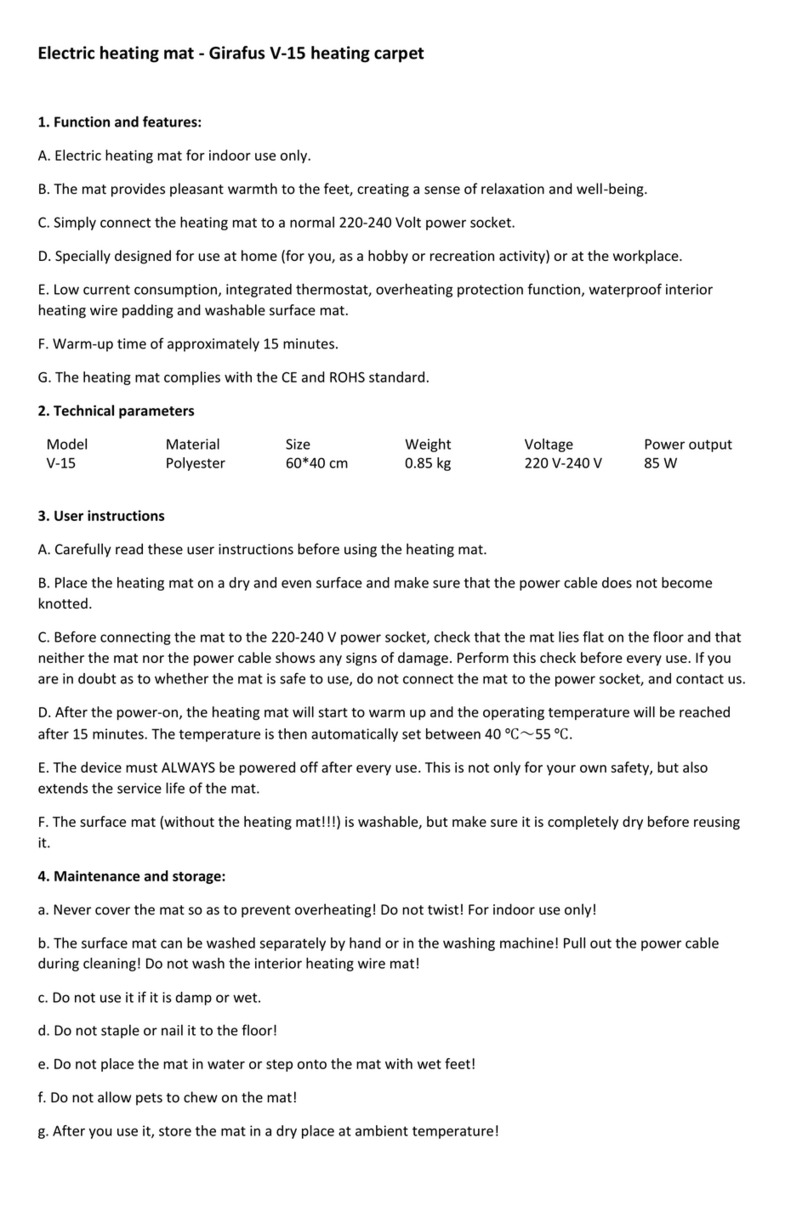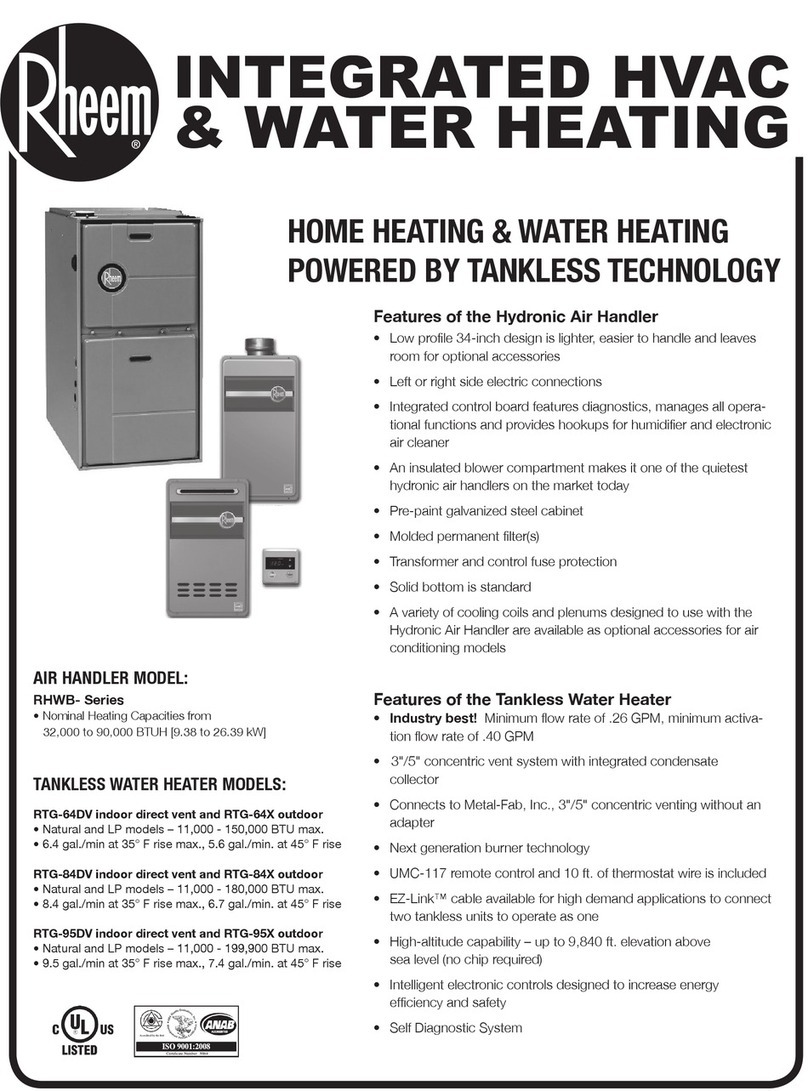SOLID AIR CPL-C User manual

INSTRUCTIONS
FOR CONTRACTORS
TYPE: CPL-C
English | Subject to modications
02-2022
6220146-202112

SOLID AIR
®
INTERNATIONAL •T +31 598 36 12 21 •www.solid-air.com •contact@solid-air.nl
TABLE OF CONTENTS
1. About this document......................................................................................................................................................................... 4
1.1 Scope..................................................................................................................................................................................................................................................4
1.2 Target group....................................................................................................................................................................................................................................4
1.3 Other applicable documents...................................................................................................................................................................................................4
1.4 Safekeeping of these documents ..........................................................................................................................................................................................4
1.5 Symbols ............................................................................................................................................................................................................................................4
1.6 Warnings.......................................................................................................................................................................................................................................... 5
2. Safety.................................................................................................................................................................................................. 6
2.1 Intended use...................................................................................................................................................................................................................................6
2.2 Safety measures............................................................................................................................................................................................................................6
2.2.1 Power supply..................................................................................................................................................................................................................................6
2.2.2 What to do in the event of a re............................................................................................................................................................................................ 7
2.3 General safety information...................................................................................................................................................................................................... 7
3. Standards and regulations .................................................................................................................................................................7
3.1 Applicable Standards and regulations ................................................................................................................................................................................ 2
3.2 For installation and maintenance, the following standards and regulations must be observed.............................................................. 2
3.3 Warnings..........................................................................................................................................................................................................................................8
4. Description......................................................................................................................................................................................... 9
4.1 CPL-C Comfort slimline ventilation unit (CPL-C 10/15/22)...........................................................................................................................................9
4.1.1 Dimensions.....................................................................................................................................................................................................................................9
4.2 CPL-C Comfort slimline ventilation unit (CPL-C 32) .....................................................................................................................................................10
4.2.1 Dimensions...................................................................................................................................................................................................................................10
4.3 Speciction .................................................................................................................................................................................................................................... 11
5. Planning ............................................................................................................................................................................................12
5.1 CPL-C installation location ..................................................................................................................................................................................................... 12
5.2 Air connection...............................................................................................................................................................................................................................13
5.2.1 Louver dampers (CPL-C 10/15/22/32).................................................................................................................................................................................
5.2.2 Servomotoren (CPL-C 10/15/22/32) ..................................................................................................................................................................................... 14
5.3 Duct connections (on site)...................................................................................................................................................................................................... 14
5.4 Trap ....................................................................................................................................................................................................................................................15
5.5 Hydraulic connection.................................................................................................................................................................................................................15
5.6 Electrical connection.................................................................................................................................................................................................................16
5.6.1 Power supply................................................................................................................................................................................................................................ 16
5.6.2 RCDs.................................................................................................................................................................................................................................................16

SOLID AIR
®
INTERNATIONAL •T +31 598 36 12 21 •www.solid-air.com •contact@solid-air.nl
6. Planning ............................................................................................................................................................................................18
6.1 Delivered condition ...................................................................................................................................................................................................................18
6.1.1 Storage............................................................................................................................................................................................................................................18
6.2 Transport........................................................................................................................................................................................................................................18
6.3 Disposal and recycling..............................................................................................................................................................................................................19
7. Commissioning ................................................................................................................................................................................20
7.1 Commissioning regulations.................................................................................................................................................................................................. 20
7.2 Commissioning procedure ......................................................................................................................................................................................................21
7.2.1 Fans ..................................................................................................................................................................................................................................................22
7.2.2 Filter pre-dryer (accesserories)..............................................................................................................................................................................................22
7.2.3 Reheater (accessories) ..............................................................................................................................................................................................................22
7.2.4 Filter monitoring.........................................................................................................................................................................................................................22
7.2.5 Countercurrent plate heat exchanger/bypass damper..............................................................................................................................................23
7.2.6 Condensate pan..........................................................................................................................................................................................................................23
7.3 Flow rate calculation.................................................................................................................................................................................................................24
7.3.1 Eective pressure calculation................................................................................................................................................................................................24
7.3.2 Eective pressure CPL-C 10.....................................................................................................................................................................................................25
7.3.3 Eective pressure CPL-C 15 .....................................................................................................................................................................................................25
7.3.4 Eective pressure CPL-C 22.....................................................................................................................................................................................................26
7.3.5 Eective pressure CPL-C 32.....................................................................................................................................................................................................26
8. Maintenance ..................................................................................................................................................................................27
8.1 Maintenance shutdown....................................................................................................................................................................................................... 27
8.2 Maintenance instructions...................................................................................................................................................................................................29
8.2.1 Electrical equipment..............................................................................................................................................................................................................29
8.2.2 Servomotors on the dampers ............................................................................................................................................................................................29
8.2.3 Trap................................................................................................................................................................................................................................................29
8.2.4 Countercurrent plate heat exchanger (PHE) ...............................................................................................................................................................29
8.2.5 Fan motor unit ........................................................................................................................................................................................................................ 30
8.2.6 Filter pre-dryer (accessories)/reheater (accessories) ............................................................................................................................................... 30
8.2.7 Bypass damper/extract air damper/outdoor air damper ..................................................................................................................................... 30
8.2.8 Compact lter.......................................................................................................................................................................................................................... 30
8.2.9 Bypass servomotor ..................................................................................................................................................................................................................31
8.2.10 Condensate pan........................................................................................................................................................................................................................31
8.3 Hygiene checklist ....................................................................................................................................................................................................................32
9. Appendix ........................................................................................................................................................................................33
9.1 CPL-C 10/15/22 ..........................................................................................................................................................................................................................33
9.2 CPL-C 32.......................................................................................................................................................................................................................................34
10. Spare parts list................................................................................................................................................................................35

4
SOLID AIR
®
INTERNATIONAL • T +31 598 36 12 21 • www.solid-air.com •contact@solid-air.nl
1. ABOUT THIS DOCUMENT
>> Read this document before you begin working on the appliance.
>> Follow the instructions in this document.
Failure to observe these instructions voids any Solid Air Climate Solutions warranty.
1.1 Scope
This document is for the Solid Air CPL-C-WRG ventilation units.
1.2 Target group
This document is intended for air conditioning, ventilation and electricity contractors.
1.3 Other applicable documents
•Wiring diagram for control.
•WRS-K instructions.
•Conguration assistant.
•Notes in the form of labels.
•The documents for all accessory modules and other accessories also apply where relevant.
1.4 Safekeeping of these documents
Documents must be kept in a suitable location and must be available at all times.
The user is responsible for the safekeeping of all documents.
The documents are provided by the contractor.
1.5 Symbols
The following symbols are used in this document:
Table 1.1 Meaning of the symbols.
Symbol Meaning
>> An action which must be taken..
qIndicates a step in images: The numbering indicates the order in which steps are taken.
➠A necessary requirement.
✔The outcome of an action.
Important information regarding the proper use of the appliance.
A reference to other relevant documents.
i

5
SOLID AIR
®
INTERNATIONAL • T +31 598 36 12 21 • www.solid-air.com •contact@solid-air.nl
1.6 Warnings
Table 1.2 Meaning of warnings.
"Safety information" identies instructions that must be observed to the letter, to prevent risks and
injuries to individuals and damage to the unit.
Danger through 'live' electrical components.
Please note: Turn o the ON/OFF switch before removing the casing.
Never touch electrical components or contacts when the ON/OFF switch is in the ON position.
There is a danger of electrocution, leading to a health risk or death.
The main terminals are 'live', even when the ON/OFF switch is in the OFF position.
"Please note" designates technical instructions which you must observe to prevent malfunction
or damage to the unit.
Please
note

6
SOLID AIR
®
INTERNATIONAL • T +31 598 36 12 21 • www.solid-air.com •contact@solid-air.nl
2. SAFETY
2.1 Intended use
Solid Air CPL-C compact ventilation units are designed to heat and lter normal air. Use of these units in rooms
with explosive atmospheres is not permissible. Handling very dusty or corrosive media is not permissible. Air intake
temperatures from -20°C to +40°C
The ventilation units, which are intended for indoor installation, must be placed in rooms that meet the requirements
of VDI2050. (VDI 2050, Requirements for technical equipment rooms - Planning and execution.)
These requirements include:
•For safety reasons, the room temperature in technical equipment rooms must not fall below 5°C (risk of frost)
or exceed 40°C.
•The unit should be operated in room conditions of between 22°C and 28°C at approx. 55% relative humidity.
•Adequately sized maintenance areas must be provided.
Any on-site modication or improper use of the unit is not permissible and
Solid Air accepts no liability for any damage caused as a result.
2.2 Safety measures
>> According to DIN 1886, tools must be used to open the unit.
>> Wait for the fan to come to a standstill (2minutes).
>> When the doors are opened, negative pressure may draw in loose objects, which could destroy the fan or even
cause a risk to life if items of clothing are drawn in.
2.2.1 Power supply
Implement the electrical connection in accordance with local regulations.
Once electrical connection work is complete, the installation must be subjected to a safety test in accordance
with VDE0701-0702 and VDE0700 part500, as otherwise there would be a risk of electric shock that could
result in injury or death.
Before working on the unit, shut it down via the isolator (accessories).
According to the Machinery Directive (2006/42/EC), this unit requires an isolator to be installed on site in
the power cable.
The isolator must be:
•Lockable.
•Capable of interrupting all poles of the supply voltage.
•Designed as a supply disconnect device to EN 60204-1.
Voltage is still present at terminals and connections of the EC fans even when the unit has been shut down.
This means there is a risk of electric shock that could result in injury or death.
Do not touch the EC fans for ve minutes after disconnecting the power across all poles.

7
SOLID AIR
®
INTERNATIONAL • T +31 598 36 12 21 • www.solid-air.com •contact@solid-air.nl
2.2.2 What to do in the event of a re
The unit does not present a direct risk of re. The small numbers of seals tted inside the unit can burn away if subjected
to external inuences.
>> If there is a re, disconnect the unit from the power supply, for example via an on-site smoke detector.
>> Wear respiratory equipment if you ght a re.
>> The usual extinguishing agents such as water, extinguishing foam or extinguishing powder can be used
to extinguish res.
As there are only a small number of ammable seals, the amount of noxious substances that could be released in a
re is minimal.
2.3 General safety information
In addition to installation and maintenance instructions, there are notes attached to the unit in the form of labels.
These must also be observed.
>> Only qualied and trained personnel may be appointed for the installation, commissioning,
maintenance and operation of the unit.
>> Only qualied electricians are permitted to work on the electrical system.
>> VDE regulations [or local regulations] and those of your local power supply utility are applicable to
electrical installation work.
>> Only operate the unit within its output range, which is stated in the technical documentation supplied
by Solid Air.
>> Only operate the unit if it is in technically sound condition.
>> Any faults or damage that impact or might impact on the safety or correct function of the unit must
be remedied immediately by qualied personnel.
>> Replace faulty components and equipment only with original Solid Air spare parts.
>> The unit may only be used for handling air. This air must not contain any harmful, combustible, explosive,
aggressive, corrosive or otherwise dangerous substances, as these would be distributed throughout the
duct system or building, where they could cause a risk to the health of, or even kill the occupants, animals
or plants living there.
Please
note

8
SOLID AIR
®
INTERNATIONAL • T +31 598 36 12 21 • www.solid-air.com •contact@solid-air.nl
3. STANDARDS AND REGULATIONS
3.1 Applicable standards and regulations
The following standards and regulations apply to the ventilation units:
•Machinery Directive 2006/42/EC.
•Low Voltage Directive 2014/35/EU.
•EMC Directive 2014/30/EU.
•ErP Directive 2009/125/EC.
•RoHS Directive 2011/65/EU.
•DIN EN ISO 12100............................................Safety of machinery - general principles for design
•DIN EN ISO 13857 ............................................Safety of machinery - safety distances
•DIN EN 349........................................................Safety of machinery- minimum clearances
•DIN EN ISO 14120 ............................................Safety of machinery - guards
•VDI 6022.............................................................Hygiene requirements for ventilation and air conditioning systems and units
•DIN EN 1886......................................................Ventilation of buildings - central air handling units
•DIN ISO 1940-1 .................................................Mechanical vibration - balance quality requirements
•VDMA 24167......................................................Fans - safety requirements
•DIN EN 60204-1...............................................Safety of machinery - electrical equipment of machines
•DIN EN 60730...................................................Automatic electrical controls
•DIN EN 61000 -6-2+3 ....................................Electromagnetic compatibility
•DIN EN 60335-1 (VDE 0700-1) ....................Safety of electrical appliances - general requirements
•VDI 3803.............................................................Central air conditioning systems - Structural and technical principles
3.2 For installation and maintenance, the following standards and regulations must be observed
•DIN EN 50106 (VDE 0700-500) .................Safety of electrical appliances - tests
•DIN VDE 0100...................................................Regulations regarding the installation of high voltage systems up to 1000V
•DIN EN 50110-1 (VDE 0105-1) ......................Operation of electrical installations
•DIN VDE 0105-100 ..........................................Operation of electrical installations - general stipulations
•DIN VDE 0701-0702........................................Inspection after repair, modication of electrical appliances, periodic inspection -
repeat testing of electrical appliances
•VDI 2050.............................................................Requirements for technical equipment rooms - Planning and execution
3.3 Warnings
>> Removal and disabling of safety and monitoring equipment is prohibited.
>> Only operate the system if it is in technically sound condition.
>> Ensure that any faults or damage that may impact on safety are rectied immediately.

9
SOLID AIR
®
INTERNATIONAL • T +31 598 36 12 21 • www.solid-air.com •contact@solid-air.nl
4. DESCRIPTION
4.1 CPL-C Comfort slimline ventilation unit (CPL-C 10/15/22)
Operating side, supply air right/supply air left = mirror inverted.
4.1.1 Dimensions
EC fan, supply air
Control unit
EC fan, extract air
Bypass damper
with servomotor
(variable speed)
Countercurrent plate
heat exchanger and
condensate pan
ISO ePM1 55 % (F7) compact
lter, outdoor air
ISO ePM10 60% (M5) compact
lter, extract air
Dierential pressure switch,
extract air lter
Outdoor air
Exhaust air
Extract air
Supply air
Dierential pressure
switch, outside air lter
Inspection
door
The illustration shows the unit with the
connection side on the right in the supply
air direction (Connection side on the left in
the supply air direction is mirror inverted).
Type CPL-C10-WRG CPL-C15-WRG CPL-C22-WRG
Height (A mm)
367 367 411
Width (B mm)
1017 1423 1830
Length (C mm)
1322 1322 1525
Control panel width (D mm)
115 115 115

10
SOLID AIR
®
INTERNATIONAL • T +31 598 36 12 21 • www.solid-air.com •contact@solid-air.nl
4.2 CPL-C Comfort slimline ventilation unit (CPL-C 32)
Operating side, supply air right/supply air left = mirror inverted.
4.2.1 Dimensions
Type CPL-C32-WRG
Height (A mm)
495
Width (B mm)
1932
Length (C mm)
1932
Outdoor air
Exhaust air
Extract airSupply air
EC fan, supply air Control unit
Dierential pressure
switch, extract air
lter
EC fan, exhaust air
Bypass damper
with servomotor
(variable speed)
Countercurrent
heat exchanger
ISO ePM1 55 % (F7)
compact lter, outdoor air
Dierential pressure switch,
outside air lter
ISO ePM10 60 % (M5)
compact lter, extract air
Inspection door
Inspection door
Bypass
Inspection door
Pan panel

11
SOLID AIR
®
INTERNATIONAL • T +31 598 36 12 21 • www.solid-air.com •contact@solid-air.nl
4.3 Specication
Size CPL-C 10-WTW 15-WTW 22-WTW 32-WTW
Max. air volume (m³/h)
1000 1500 2200 3200
At available ext. pressure, supply air (Pa)
445 380 220 600
At available ext. pressure, extract air (Pa)
470 395 170 610
Heat recovery rate (%)
> 90 > 90 > 90 > 90
Height (A mm)
367 367 411 495
Width (B mm)
1017 1423 1830 1932
Length (C mm)
1322 1322 1525 1932
Control panel width (D mm)
115 115 115 -
Internal duct connection dimensions (mm)
409 x 247 612 x 247 815 x 291 866 x 354
Weight (kg)
140 180 240 360
Motor data for each fan CPL-C 10-WTW 15-WTW 22-WTW 32-WTW
Mains voltage (V)
1 x 230V 1 x 230V 1 x 230V 3 x 400V
Frequency (Hz)
50/60 50/60 50/60 50/60
Max. power consumption (W)
500 750 750 2100
Max. current consumption (A)
2,3 3,3 3,3 3,3
Speed (t/min.)
3080 3450 3000 3450
Energ eciency class
IE4 IE4 IE4 IE4
IP rating
IP55 IP55 IP55 IP55
Protection class
Iso F Iso F Iso F Iso F
Power cable CPL-C 10-WRG-PWW 15-WRG-PWW 22-WRG-PWW 32-WRG-PWW
Supply voltage (V)
1 x 230V 3 x 400V 3 x 400V 3 x 400V
Cable cross-section (mm²)
3 x 1,5 mm² 5 x 1,5 mm² 5 x 1,5 mm² 5 x 2,5 mm²
On-site fuse (A)
16 A 16 A 16 A 20 A
Power cable CPL-C 10-WRG-E-Reg. 15-WRG-E-Reg. 22-WRG-E-Reg. 32-WRG-E-Reg.
Supply voltage (V)
1 x 230V 3 x 400V 3 x 400V 3 x 400V
Cable cross-section (mm²)
3 x 1,5 mm² 5 x 2,5 mm² 5 x 2,5 mm² 5 x 6 mm²
On-site fuse (A)
16 A 20 A 20 A 35 A

12
SOLID AIR
®
INTERNATIONAL • T +31 598 36 12 21 • www.solid-air.com •contact@solid-air.nl
5.1 CPL-C installation location
>>
The CPL-C is designed as an indoor unit and intended solely for ceiling installation.
>>
The ceiling where the unit will be mounted must be level and suciently load bearing (min. 500kg/m²).
>>
Only install the unit with the standard suspension brackets supplied, as shown in the illustration.
>>
For the CPL-C-32, we recommend using the drilled hole in the middle of the suspension bracket.
>>
The lifting lugs tted to the CPL-C-32 as standard are intended for lifting and turning the unit. Never use
them for mounting the unit on the ceiling. After use, the lifting lugs can be removed and the drilled holes
sealed with the supplied blanking plugs.
>>
Never drill holes or insert screws in the ceiling panels, as this may damage the electric cables under
the panels.
>>
The installation location must meet the requirements of VDI 2050.
>>
Provide sucient space below the unit for maintenance work.
>>
Site the unit in a room that is free from the risk of frost.
>>
Provide a drain connection for discharging any condensate that may be generated.
Suspension bracket for CPL-C 10/15/22/32 Dimensioning for CPL-C 10/15/22/32
5. PLANNING
70-15070-150
70-150
70-150
Minimum clearance between
outdoor air intake and exhaust
air outlet to prevent an
"air short circuit" (DIN 13779).
> 3m
> 2m
Supply air
Outdoor air
Extract air
Exhaust air
Please
note

13
SOLID AIR
®
INTERNATIONAL • T +31 598 36 12 21 • www.solid-air.com •contact@solid-air.nl
5.2 Air connection
Air duct connections are identied with the following labels:
Outdoor air Exhaust air
Extract air Supply air
Operating side, supply air left Operating side, supply air right
Plan view Plan view
AUL / ODA
6801059 48/10
AUL / ODA
ABL /ETA
ABL /ETA
6801061 48/10
FOL/EHA
6801062 48/10
FOL/EHA
ZUL/SUP
6801060 48/10
ZUL/SUP
AL AL
TL TL
BL BL
RL RL
only for CPL-C 10 / 15 / 22 only for CPL-C 10/15/22

14
SOLID AIR
®
INTERNATIONAL • T +31 598 36 12 21 • www.solid-air.com •contact@solid-air.nl
5.2.1 Louver dampers (CPL-C 10/15/22/32)
>>
Always t the louver dampers as shown in the illustration!
5.2.2 Servomotoren (CPL-C 10/15/22/32)
>>
Secure servomotors with the supplied mounting bracket,
as shown in the illustration.
>>
For model size CPL-C-32, rivet the mounting bracket to the damper.
5.3 Duct connections (on site)
The connectors of the unit are rectangular. Round ducts can be connected directly
to the connectors using an adaptor module from square to round (accessories).
Insulate the ducts, including external dampers, exible connections and insulating
frames, in accordance with applicable regulations and industry standards.
Mounting bracket

15
SOLID AIR
®
INTERNATIONAL • T +31 598 36 12 21 • www.solid-air.com •contact@solid-air.nl
5.4 Trap
The eective trap head h (mm) must be greater than the maximum under- or overpressure at the
condensate connector (1mm WC = 10Pa).
•Do not connect the trap drain line directly to the public sewage system.
•It must be able drain o freely.
•Vent longer drain lines to prevent condensate backing up in the line (provide additional opening in trap drain line).
5.5 Hydraulic connection
h = 1,5 x p (mm WC) + 50 mm (min.)
p = Under- or overpressure in mmWC acc. to appliance design.
50 mm (WC) = Reserve (inaccuracy in design, evaporation).
1,5 = Additional safety factor.
Balsifon Sifon
i
Heating coil (hydraulic connection example)
Admixing circuit
Benets: good control characteristics, low risk of freezing.
Cooling coil (hydraulic connection example)
Diverting circuit
Benets: constant ow temperature in cooling coil,
good dehumidication even at partial load.
ϑ1 =ϑ2
Note: positioning valves close to the heat exchanger improves the control characteristics.

16
SOLID AIR
®
INTERNATIONAL • T +31 598 36 12 21 • www.solid-air.com •contact@solid-air.nl
5.6 Electrical connection
5.6.1 Power supply
The electrical connection may only be implemented by electricians in accordance with local regulations.
When connecting the control unit and control accessories, observe the instructions and wiring diagrams
provided.
Once electrical connection work is complete, the installation must be subjected to a safety test in accordance
with VDE0701-0702, as otherwise there may be a risk of electric shock that could result in injury or death.
Before working on the unit, shut it down via the isolator (accessories).
According to the Machinery Directive (2006/42/EC), this unit requires an isolator to be installed on site in the
power cable.
The control panel on/in the unit features an aperture for connecting on-site cables.
Voltage is still present at terminals and connections of the EC fans even when the unit has been shut down.
This means there is a risk of electric shock that could result in injury or death.
Do not touch the EC fans for ve minutes after disconnecting the power across all poles.
Use a rubber mat if working on the unit when it is electrically charged.
Only use cables that meet local wiring regulations with regard to voltage, current, insulation material, load
capacity, etc. Always t an earth conductor.
Connecting cables, installation ducts or tubes, etc. must be protected from mechanical damage.
5.6.2 RCDs
Only AC/DC-sensitive fault current safety devices, type B, with 300mA are permissible. There is no personal
safety protection if the unit is operated with RCDs.
Press the test button every six months to check that the residual current devices (RCDs) are functioning
properly.
Regularly check that all electrical equipment is working correctly.
Observe the specied electrical MCB/fuse protection ratings.
We accept no liability for any damage or loss resulting from technical modications to Solid Air control units.

17
SOLID AIR
®
INTERNATIONAL • T +31 598 36 12 21 • www.solid-air.com •contact@solid-air.nl
Image: CPL-C 10/15/22
Image: CPL-C 32
Entry for on-site cables
Entry for on-site cables
Open bypass
inspection door
Remove cover plate from
control unit and connect cables
according to wiring diagrams.
Check cover plate for leak
tightness when installing.

18
SOLID AIR
®
INTERNATIONAL • T +31 598 36 12 21 • www.solid-air.com •contact@solid-air.nl
6.1 Delivered condition
Fig. 6.1 CPL-C delivered condition
•
CPL-C ventilation units are supplied in packaging that protects them from dirt and damage.
•
Upon receipt of the goods, check the unit for possible transport damage.
>>
If there is any damage or even a suspicion of damage, the recipient must indicate this on the consignment note and
have it countersigned by the haulier. The recipient of the goods must notify Solid Air of the relevant facts without delay.
>>
Dispose of the transport packaging in accordance with local regulations.
6.1.1 Storage
>>
Only store the ventilation unit in dry rooms at an ambient temperature between -25°C and +55°C.
>>
If it is stored for a long time, ensure that all apertures are sealed against air and water ingress.
6.2 Transport
When transporting units through doors or in narrow stairwells (lifts), tilt model sizes CPL-C10/15/22 onto their narrow
side. Ensure that the control cabinet and condensate drain are pointing upwards. The CPL-C-32 can optionally be equipped
with a transport carriage for transporting the unit through low openings (e.g. clearance height of 1950mm). This carriage
simplies movement of the unit without a shipping pallet, while protecting the unit surface from damage. Attachment
points for pulling equipment are integrated in the transport carriage.
CPL-C 10/15/22 CPL-C 32
Image: CPL-C 10/15/22 tilted Image: CPL-C 32 on carriage
6. INSTALLATION
Transport
carriage

19
SOLID AIR
®
INTERNATIONAL • T +31 598 36 12 21 • www.solid-air.com •contact@solid-air.nl
6.3 Disposal and recycling
>> When the appliance reaches the end of its service life, it may only be dismantled by qualied personnel.
>> Before starting to dismantle the appliance, disconnect the power supply.
>> Power cables must be removed by qualied electricians.
>> Sort and dispose of metal and plastic parts according to material types and in compliance with local regulations.
>> Dispose of electrical and electronic components as electrical waste.

20
SOLID AIR
®
INTERNATIONAL • T +31 598 36 12 21 • www.solid-air.com •contact@solid-air.nl
7. COMMISSIONING
7.1 Commissioning regulations
Commissioning and maintenance work must only be carried out by trained personnel.
Only work on the unit when it is at zero volt.
According to EN 50110-1 (VDE 0105-1), only qualied electricians may carry out the installation and
commissioning of the ventilation control unit and connected accessories.
Observe all regulations stipulated by your local power supply utility and all VDE regulations.
DIN VDE 0100 regulations regarding the installation of high voltage systems up to 1000V
DIN VDE 0105-100 Operation of electrical installations
Only original Solid Air accessories may be used (electric coils, servomotors, etc.), otherwise Solid Air cannot
accept any liability.
Before commissioning, check whether the operating data specied on the type plate is adhered to.
The unit must not be operated before all necessary safety equipment has been tted and connected. Intake
and discharge apertures must be connected to ensure contact protection. The CPL-C-WRG unit must be level
and safely secured.
Commissioning must be carried out by authorised personnel (Solid Air Customer Service).
Record the date of commissioning, e.g. in a log book.
According to DIN 1886, tools must be used to open the unit. Wait for the fans to come to a complete standstill
before opening the inspection doors. When opening the doors, negative pressure may draw in loose objects,
which could damage the fan irreparably or even cause a risk to life if items of clothing are drawn in. Use tools
to tightly seal the doors before commissioning (unit tightness).
This manual suits for next models
15
Table of contents
Popular Heating System manuals by other brands
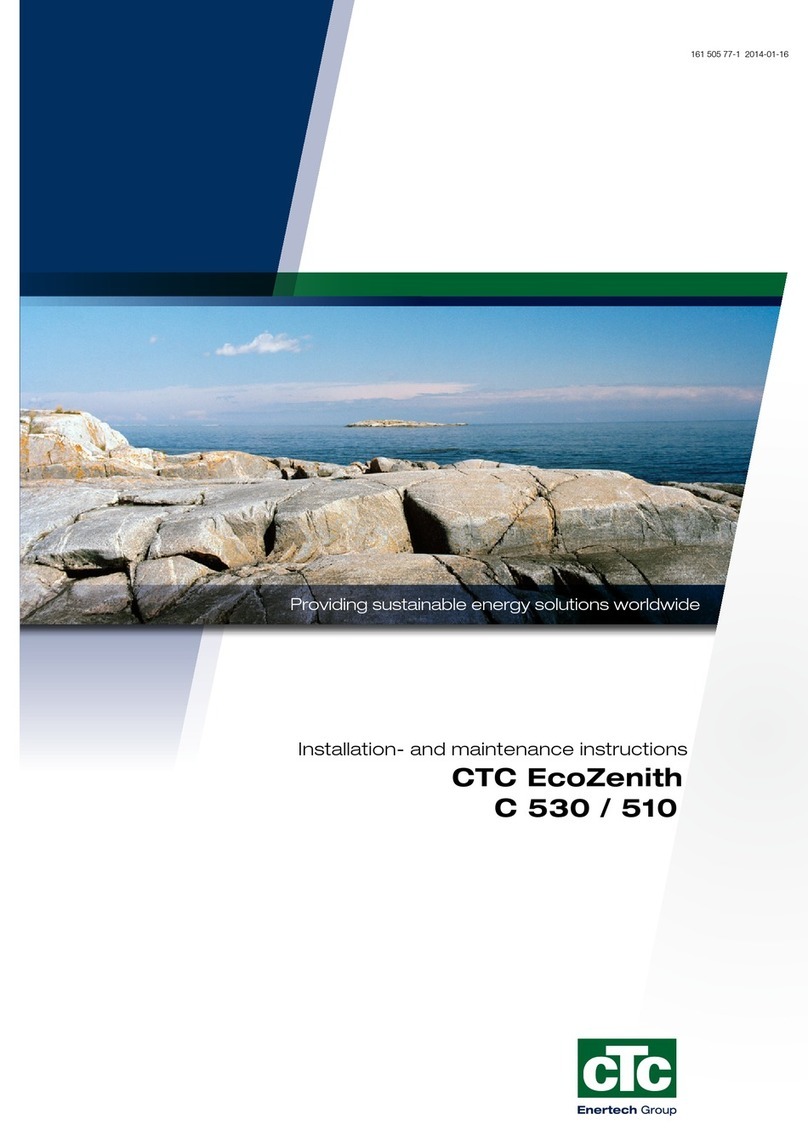
CTC Union
CTC Union EcoZenith C 530 Installation and maintenance instructions
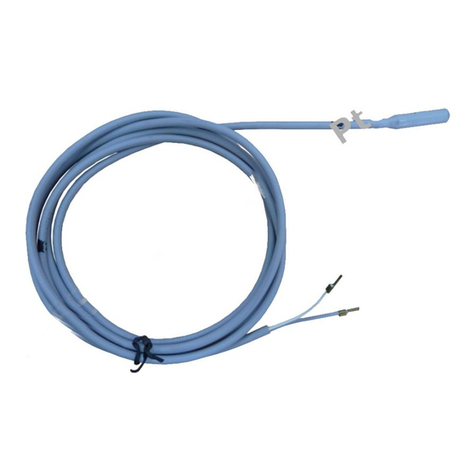
ISOPAD
ISOPAD Thermocoax IT-KDL Series operating instructions

Tecnosystemi
Tecnosystemi Apply HI-TECH PUR user manual
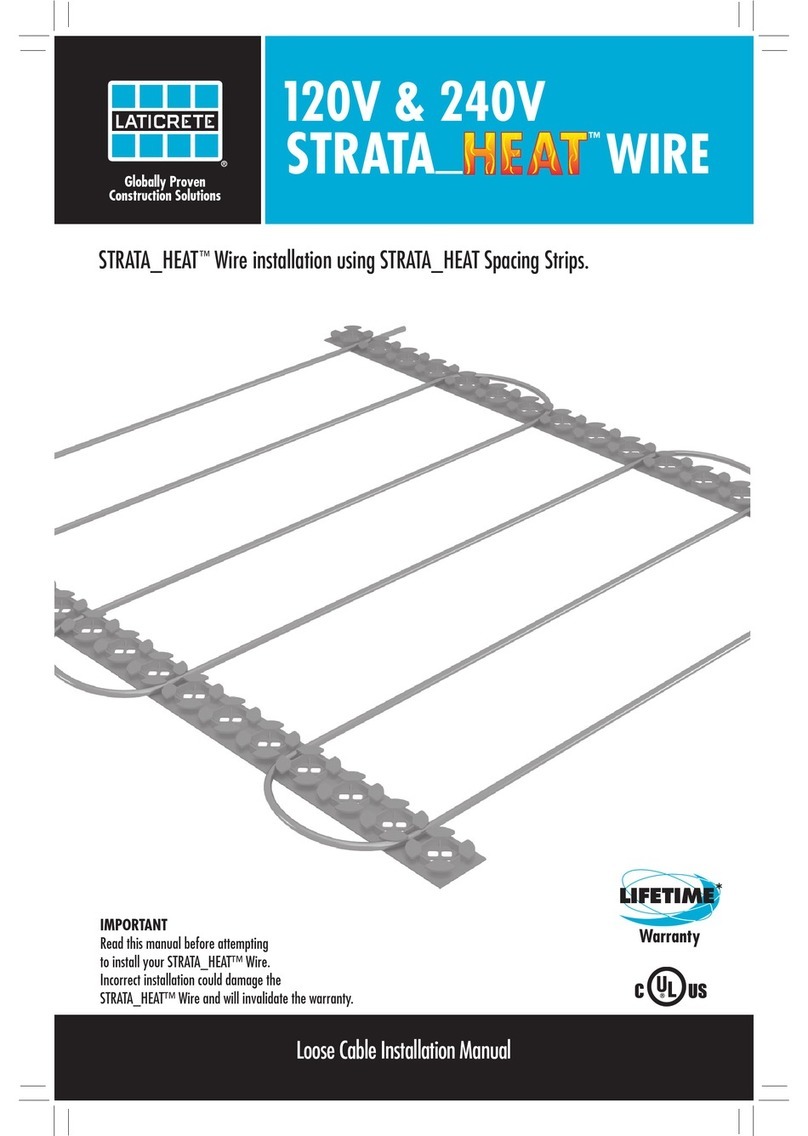
LATICRETE
LATICRETE STRATA_HEAT 0802-0067-2 installation manual

Bosch
Bosch Worcester Greenstar HIU User instructions

AEG
AEG SLH 25/5 ST Operation and installation
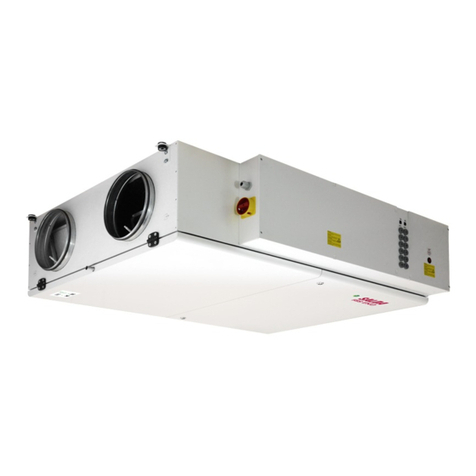
Salda
Salda RIS 400 P EKO 3.0 Series MOUNTING AND INSTALLATION INSTRUCTION
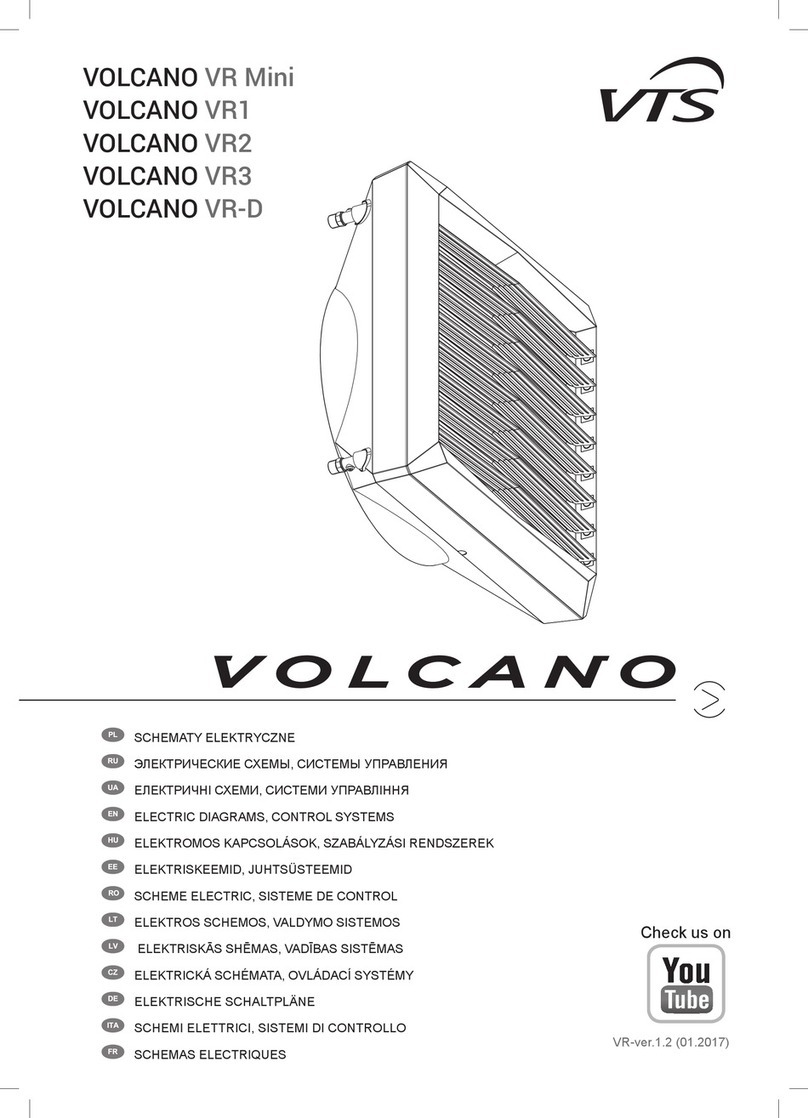
VTS Medical Systems
VTS Medical Systems VOLCANO Series manual
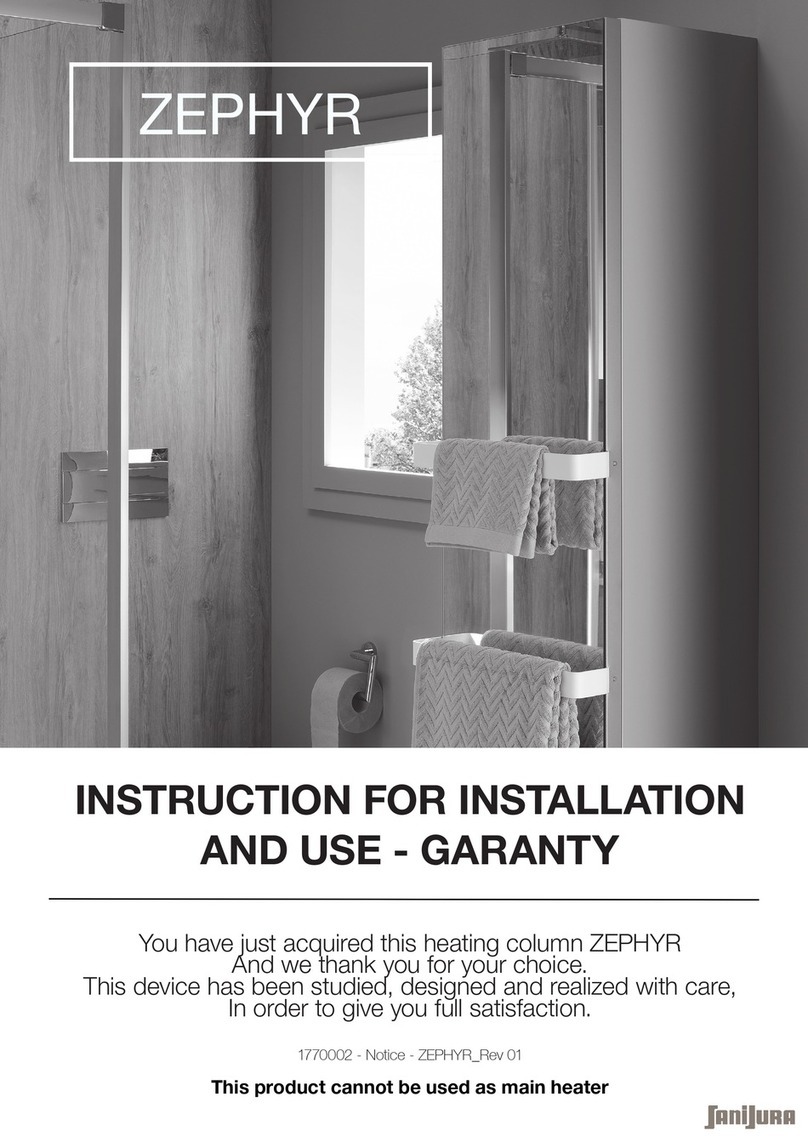
SaniJura
SaniJura ZEPHYR Instructions for installation and use
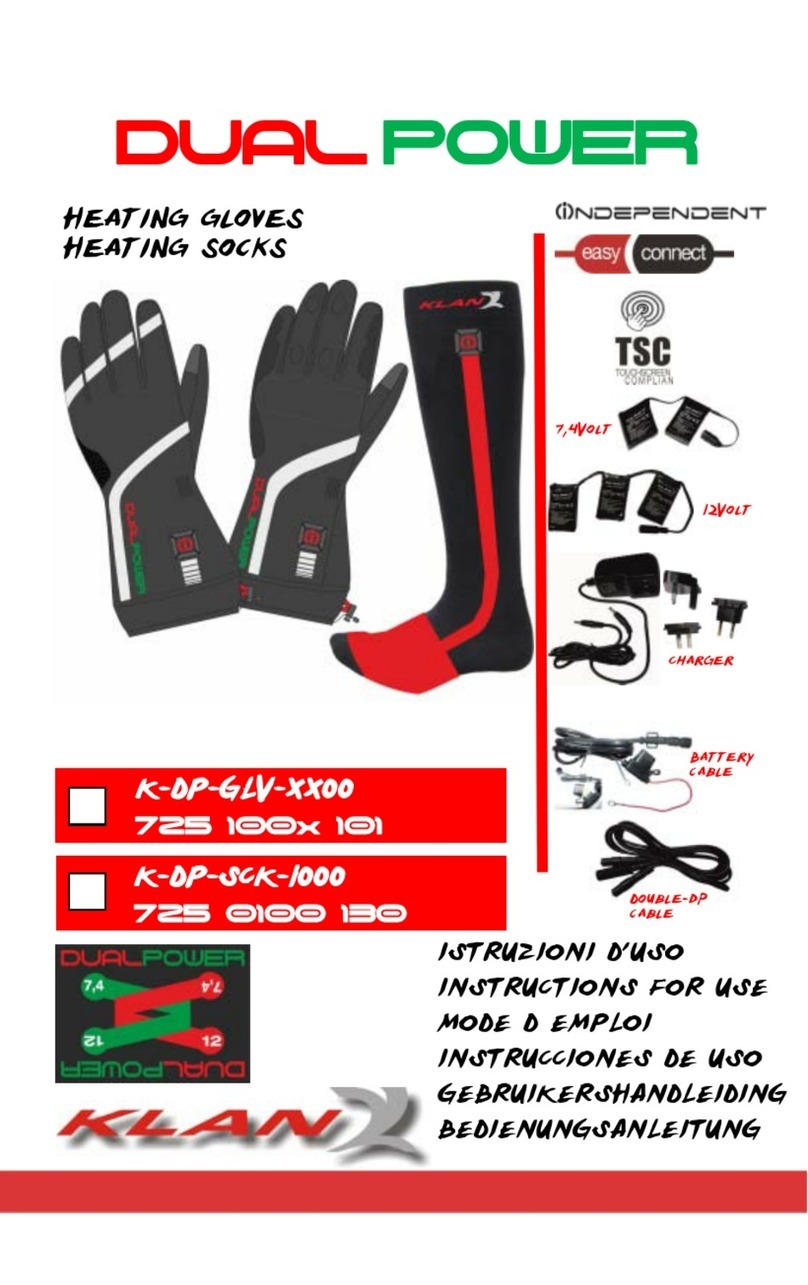
KLAN
KLAN K-DP-GLV Series Instructions for use
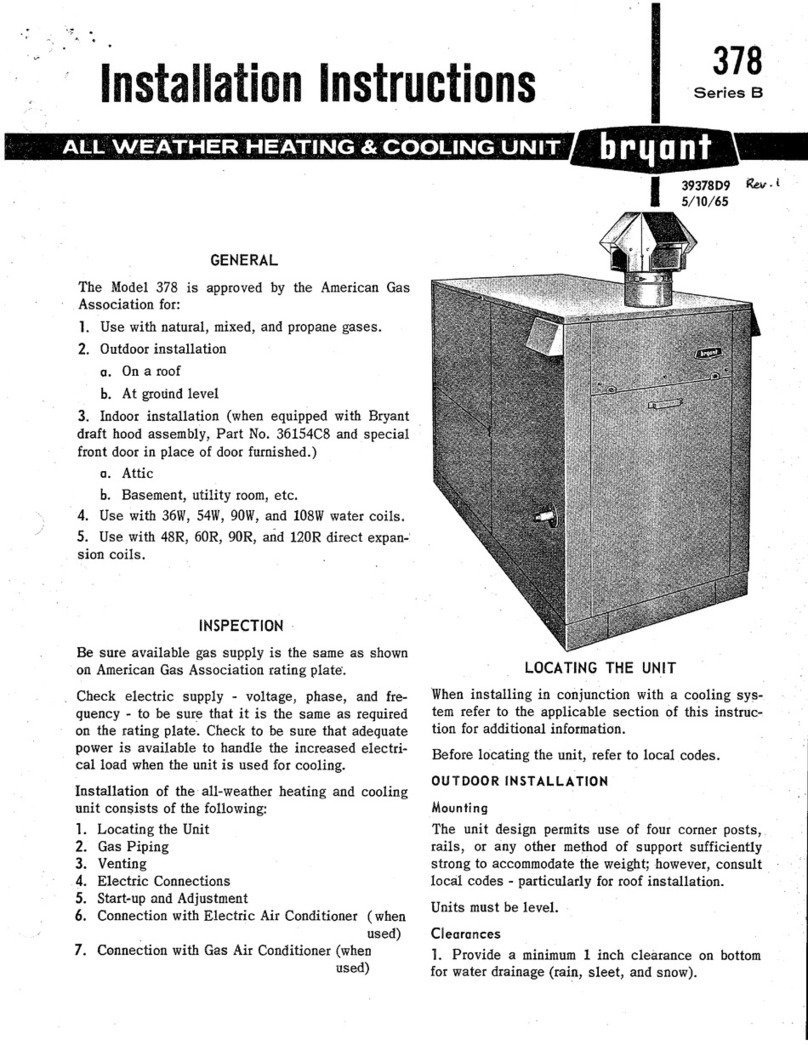
Bryant
Bryant 378 installation instructions

Vortice
Vortice PRE-HEATING BOX Instruction booklet

